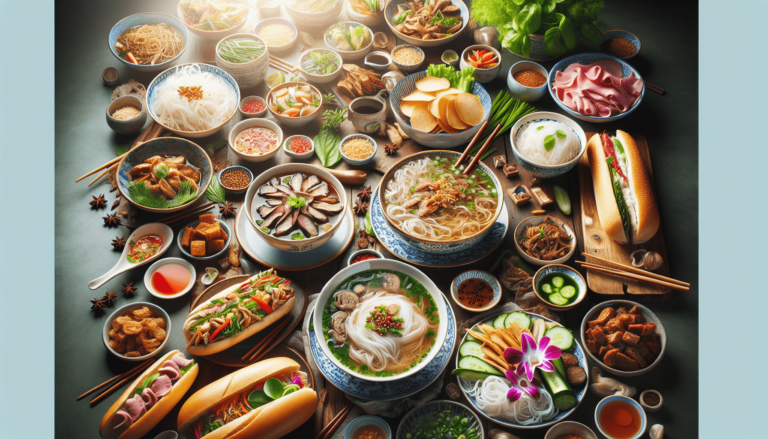Craving a comforting bowl of soup while watching your waistline? Look no further than Pho Soup. Bursting with flavorful broth, tender rice noodles, and an array of fresh herbs and vegetables, Pho Soup is not only a delightful culinary experience but also a worthy addition to a balanced diet. Packed with lean protein from the traditional meat or tofu options, and low in fat and calories, this Vietnamese specialty can be a satisfying and nutritious choice for those seeking a healthier lifestyle. So, why not head over to Eurasian Bistro, with their conveniently located Pensacola locations, to try their delicious Pho Soup and see for yourself how it can fit perfectly into your diet?
Understanding Pho Soup
Pho soup is a traditional Vietnamese dish that has gained immense popularity worldwide. This delicious and hearty soup is not only pleasing to the taste buds but also offers several health benefits. In this article, we will delve deeper into the origin of pho soup, its components, traditional preparation method, nutritional value, and its role in a balanced diet. We will also explore how pho soup can aid in weight loss, discuss common additives and their nutritional impacts, and provide variations of pho soup for different diet types. Additionally, we will highlight the health benefits of pho soup, potential drawbacks, and provide tips for making a diet-friendly version. Lastly, we will suggest some restaurants, particularly Eurasian Bistro, where you can enjoy a delicious and diet-friendly bowl of pho soup. So, let’s dive in and uncover the wonders of pho soup!
Origin of Pho Soup
Pho soup originated in Northern Vietnam during the early 20th century and quickly gained popularity throughout the country. The origins of the word “pho” are debated, but it is commonly believed to have stemmed from the French word “pot-au-feu,” which means “pot on fire.” This is likely due to the influence of French colonization in Vietnam, which introduced new culinary techniques and ingredients. Over time, pho soup evolved into a beloved Vietnamese dish, eaten by people of all walks of life, from street vendors to high-end restaurants.
Components of Pho Soup
Pho soup is a complex and flavorful dish that consists of various components. The base of the soup is a rich and aromatic broth, typically made by simmering beef bones or chicken carcasses for several hours. This slow-cooking process extracts the flavors and nutrients from the bones, resulting in a savory and nourishing broth. The broth is then flavored with a combination of aromatic spices, including star anise, cloves, cinnamon, cardamom, and coriander.
Along with the broth, pho soup contains rice noodles, which are cooked separately and added to the bowl before the hot broth is poured over them. The noodles provide a satisfying chewiness to the soup and act as a staple ingredient. Additionally, pho soup is often served with a variety of garnishes and toppings, such as thinly sliced beef or chicken, bean sprouts, Thai basil, lime wedges, and jalapenos. These fresh elements add texture, flavor, and nutritional value to the soup.
Traditional Preparation Method
The traditional preparation method of pho soup involves a meticulous and time-consuming process that results in a flavorful and nutritious dish. It begins with the slow simmering of meat bones, such as beef or chicken, along with a combination of aromatic spices, herbs, and vegetables. This slow cooking process allows the flavors to meld and the nutrients to be extracted from the bones, resulting in a rich and nourishing broth.
The next step involves straining the broth to remove any impurities and clarifying it further. This ensures a clear and clean base for the soup. The rice noodles are cooked separately, and the toppings and garnishes are prepared fresh. When serving pho soup, the noodles are placed in a bowl, and the desired meat and garnishes are added. Then, the piping hot broth is poured over the ingredients, cooking the meat and creating an aromatic and comforting bowl of pho.
Nutritional Value of Pho Soup
Pho soup not only satisfies the taste buds but also offers a range of essential nutrients. Let’s explore the macronutrients, vitamins and minerals content, and calorie content in a typical bowl of pho soup.
Macronutrients in Pho Soup
A bowl of pho soup typically contains a balanced blend of macronutrients, which are the building blocks of our diet. The exact macronutrient content may vary depending on the type of meat and toppings used, but generally, pho soup provides a moderate amount of carbohydrates, proteins, and fats. The rice noodles contribute to the carbohydrate content, providing energy for the body. Protein is primarily derived from the meat used in the soup, which can be beef, chicken, or even tofu for vegan options. Fats are present in the broth and the meat, providing flavor and satiety.
Vitamins and Minerals Content
Pho soup also packs a punch when it comes to vitamins and minerals. The broth, made from simmering bones and vegetables, is rich in essential minerals like calcium, phosphorus, magnesium, and potassium. These minerals play a crucial role in maintaining bone health, nerve function, and electrolyte balance. Additionally, the garnishes and toppings, such as bean sprouts, Thai basil, and lime, provide a generous amount of vitamins like vitamin C and vitamin K. These vitamins are important for boosting the immune system, promoting healthy blood clotting, and supporting overall well-being.
Calorie Content
The calorie content of a bowl of pho soup can vary depending on the portion size and the ingredients used. On average, a regular-sized bowl of pho soup contains approximately 350 to 500 calories. This moderate calorie content makes pho soup a suitable option for those looking to manage their weight while enjoying a flavorful and nourishing meal. However, it is important to note that additional calorie-dense toppings, such as fried shallots or fatty cuts of meat, can significantly increase the calorie content. Therefore, it is advisable to be mindful of portion sizes and choose healthier toppings to keep the calorie count in check.

Pho Soup in a Balanced-Diet Context
Pho soup can be a healthy and delicious addition to a balanced diet. Let’s explore its role in promoting a balanced diet, understand recommended daily nutrient intake, and compare pho soup’s nutrient content with daily intake guidelines.
Role of Pho Soup in Promoting Balanced Diet
A balanced diet consists of a variety of foods that provide essential nutrients in the right proportions. Pho soup can contribute to a balanced diet by offering a combination of carbohydrates, proteins, fats, vitamins, and minerals. The rice noodles provide complex carbohydrates for energy, while the meat or tofu adds a good source of protein. The broth, with its mineral-rich base, adds valuable nutrients to the soup. By including fresh herbs and vegetables as toppings, pho soup becomes an excellent source of vitamins and fiber. Overall, incorporating pho soup into one’s diet can contribute to a diverse and nutrient-packed meal plan.
Understanding Recommended Daily Nutrient Intake
Understanding recommended daily nutrient intake is crucial for maintaining optimal health. The recommended daily nutrient intake varies depending on age, sex, weight, and activity level. Generally, a balanced diet should consist of approximately 45-65% carbohydrates, 10-35% protein, and 20-35% fats. Additionally, the intake of vitamins, minerals, and fiber should be balanced and obtained from a variety of food sources. By being mindful of these recommended daily nutrient intake guidelines, individuals can make informed choices when incorporating pho soup into their diet.
Comparison of Pho Soup Nutrient Content with Daily Intake
When compared to the recommended daily nutrient intake, a bowl of pho soup can provide a significant portion of several essential nutrients. The carbohydrates from the rice noodles contribute to the daily carbohydrate intake, while the meat or tofu adds to the daily protein intake. The broth, with its mineral content, helps meet the daily mineral requirements. Moreover, the fresh herbs and vegetables used as toppings offer a range of vitamins to support overall health. While pho soup alone may not meet all daily nutrient requirements, it serves as a valuable and nutritious addition to a well-rounded and balanced diet.
Pho Soup and Weight Loss
Pho soup can be a valuable ally for those looking to lose weight. Its unique combination of ingredients and cooking method makes it an ideal option for promoting satiety, controlling calorie intake, and maintaining energy levels during a calorie-restricted diet.
How Pho Soup Promotes Satiety
Pho soup’s ability to promote satiety can be attributed to its high water and fiber content. The broth and the generous use of vegetables in pho soup contribute to its high water content, which adds volume to the meal. This can help individuals feel fuller for longer without consuming excessive calories. Additionally, the fiber from the vegetables and rice noodles adds bulk to the soup, further enhancing satiety. By promoting a feeling of fullness, pho soup can prevent overeating and contribute to successful weight loss efforts.
Role of Pho Soup in Calorie Control
Pho soup can be a great tool for calorie control due to its customizable nature. The broth-based soup provides a flavorsome base that can be enhanced with different types and cuts of meat or even plant-based proteins. By choosing lean cuts of meat or opting for plant-based proteins like tofu, individuals can control the calorie and fat content of the soup. Moreover, by keeping the portion size in check and avoiding calorie-dense toppings, individuals can further ensure they stay within their calorie limits. Pho soup’s versatility allows for customization to fit specific dietary needs and weight loss goals.
Role of Pho Soup in Maintaining Energy Levels during a Diet
When following a calorie-restricted diet, maintaining energy levels can be a challenge. Pho soup can play a vital role in providing sustained energy due to its balanced macronutrient composition. The carbohydrates from the rice noodles provide a source of energy, while the proteins in the meat or tofu offer satiety and help preserve muscle mass. Additionally, the broth adds flavor and depth, making the meal enjoyable and satisfying. By incorporating pho soup into a calorie-controlled diet, individuals can ensure they have the energy required to carry out their daily activities without feeling deprived.

Common Additives to Pho Soup and Their Nutritional Impacts
Pho soup can be customized with various additives, such as different types of meats, vegetables, sauces, and spices. Let’s explore the nutritional impacts of these common additives and how they can contribute to the overall nutritional value of pho soup.
Different Types of Meat and Their Nutrient Content
Different types of meat can be used in pho soup, including beef, chicken, and even pork. Each type of meat brings its unique nutrient profile to the dish. Beef is a rich source of protein, iron, zinc, and vitamin B12. Chicken provides lean protein, vitamins like niacin and vitamin B6, and minerals like selenium. Pork contributes to the overall flavor of the soup and provides B vitamins, zinc, and phosphorus. By selecting different types of meat, individuals can diversify their nutrient intake and cater to their specific dietary preferences.
Different Types of Vegetables and Their Nutrient Content
Pho soup can be elevated with various vegetables, each offering its nutritional benefits. Bean sprouts, commonly used as a garnish, provide vitamin C, folate, and fiber. Thai basil adds a fresh and aromatic note to the soup while providing vitamin K, iron, and calcium. Lime wedges contribute a burst of tangy flavor and offer vitamin C. Other vegetables like scallions, onions, and cilantro can be added for additional flavor and nutritional value. By incorporating a diverse range of vegetables, pho soup becomes a nutrient-dense and vibrant meal choice.
Impact of Sauces and Spices on Pho Soup’s Nutritional Value
Pho soup is often served with various sauces and spices, such as hoisin sauce, Sriracha, or fish sauce. While these condiments enhance the flavor of the soup, they should be consumed in moderation due to their high sodium and sugar content. It is advisable to choose low-sodium versions of sauces or limit the amount used. Alternatively, natural spices like chili flakes, garlic, and ginger can be added to elevate the taste without adding excessive sodium or sugar. By being mindful of the sauces and spices used, individuals can maintain the nutritional integrity of their pho soup.
Variations of Pho Soup for Different Diet Types
Pho soup can be adapted to suit various dietary preferences and restrictions. Let’s explore how pho soup can be enjoyed on a vegan diet, a gluten-free diet, and a high-protein diet.
Pho Soup for a Vegan Diet
For individuals following a vegan diet, pho soup can be easily customized by omitting meat and opting for plant-based proteins. Tofu can be used as a substitute for meat, providing a good source of protein. Vegetables can be added generously, offering fiber, vitamins, and minerals. Plant-based sauces like soy sauce or tamari can be used instead of fish sauce, ensuring the vegan-friendly status of the soup. With these modifications, pho soup becomes a satisfying and nourishing option for those following a vegan lifestyle.
Pho Soup for a Gluten-Free Diet
Individuals with gluten intolerance or following a gluten-free diet can still enjoy pho soup with a few adjustments. The rice noodles used in pho soup are naturally gluten-free, making them a safe and suitable option. However, it is essential to check if the broth and the sauces used are gluten-free, as some commercial products may contain gluten-containing ingredients. To ensure a gluten-free pho soup, it is advisable to make homemade broth or use certified gluten-free products. By making these simple adjustments, individuals following a gluten-free diet can savor the flavors of pho soup without any concerns.
Pho Soup for a High-Protein Diet
Pho soup can be a fantastic option for individuals on a high-protein diet. By selecting meat cuts that are higher in protein content, such as lean beef or chicken breast, the overall protein intake of the soup can be significantly increased. Additionally, the use of bean sprouts and tofu as additional protein sources can boost the protein content further. By focusing on protein-rich ingredients and carefully portioning the soup, individuals can align pho soup with their high-protein dietary goals.
Health Benefits of Pho Soup
Pho soup offers a plethora of health benefits beyond its delightful taste. Let’s explore how pho soup can contribute to heart health, digestive health, and overall immunity.
Pho Soup and Heart Health
Pho soup can be a heart-healthy choice due to its nutrient composition. The use of lean meats and the absence of excessive fats in the soup make it a low-saturated fat option. Saturated fats are known to increase cholesterol levels and increase the risk of heart disease. The minerals, such as potassium and magnesium, found in the broth can also support heart health by regulating blood pressure and maintaining a healthy heartbeat. By incorporating pho soup into a balanced diet, individuals can make conscious choices that contribute to their overall heart health.
Pho Soup and Digestive Health
Pho soup contains a generous amount of fiber from the vegetables and rice noodles, which is essential for maintaining a healthy digestive system. Fiber adds bulk to the stool, promoting regular bowel movements and preventing constipation. Additionally, the slow cooking process of the broth helps break down collagen from the bones into gelatin, which can support gut health and improve digestion. By including fiber-rich pho soup in their diet, individuals can ensure optimal digestive health and improve nutrient absorption.
Pho Soup and Immunity
Pho soup’s combination of fresh herbs, vegetables, and a rich broth makes it a nourishing choice for strengthening the immune system. The immune-boosting properties of pho soup can be attributed to various vitamins and minerals present in the ingredients. The broth, made from simmering bones and vegetables, provides minerals like zinc, which is essential for immune function. Fresh herbs like Thai basil and coriander offer antioxidants and vitamin C, which can aid in reducing inflammation and supporting the immune system. By enjoying a bowl of pho soup regularly, individuals can fortify their immune defenses and stay healthy.
Possible Drawbacks of Consuming Pho Soup for Diet
While pho soup offers numerous health benefits, it is important to be aware of certain potential drawbacks, especially for individuals following a specific diet plan. Let’s explore the drawbacks of consuming pho soup to make informed dietary choices.
High Sodium Content in Pho Soup
Pho soup, particularly when commercially prepared or consumed at restaurants, can have a high sodium content. The use of sauces, condiments, and commercially prepared broths can significantly increase the sodium levels in the soup. Excessive sodium intake can lead to fluid retention, high blood pressure, and increased risk of cardiovascular diseases. To mitigate the impact of high sodium content, it is advisable to choose low-sodium broths, use natural spices for flavoring, and limit the intake of high-sodium sauces. By being mindful of sodium intake, individuals can enjoy pho soup without compromising their health.
Risk of Consuming Too Much Unhealthy Meat Cuts
While pho soup can be customized with a variety of meat cuts, it is essential to choose wisely to avoid excessive consumption of unhealthy meats. Fatty cuts of meat, such as brisket or beef tendon, can significantly increase the calorie and saturated fat content of the soup. Excessive intake of saturated fats is linked to an increased risk of heart disease and other health complications. It is advisable to opt for leaner cuts of meat, such as eye of round or chicken breast, to keep the fat content in check. By making informed choices about meat cuts, individuals can enjoy the benefits of pho soup without compromising their dietary goals.
Potential for Overeating Due to Pho Soup’s Delicious Taste
One potential drawback of pho soup is its delicious taste, which can lead to overeating. The flavorful broth, the aromatic spices, and the combination of ingredients can make it difficult to stop at just one bowl. Additionally, the large portion sizes typically served at restaurants can contribute to excessive calorie intake. It is important to be mindful of portion sizes and avoid additional calorie-dense toppings to ensure that pho soup remains a healthy part of the diet. By practicing portion control and being conscious of hunger cues, individuals can savor the taste of pho soup without overindulging.
Tips for Making a Diet-Friendly Pho Soup
Creating a diet-friendly version of pho soup is simple with a few key considerations. Here are some tips for making a flavorful and nutritious pho soup that aligns with your dietary goals:
Choosing Lean Meat Cuts or Plant-Based Proteins
When preparing pho soup at home, opt for lean cuts of meat like eye of round or skinless chicken breast. Trim any visible fat before adding the meat to the soup. Alternatively, choose plant-based proteins like tofu or tempeh for a vegetarian or vegan option. These protein sources provide high-quality nutrients without excessive fat or cholesterol.
Limiting Salt and Using Natural Spices
To keep the sodium content in check, limit the amount of salt added to the soup. Instead, rely on natural spices like chili flakes, ginger, garlic, and herbs to enhance the flavor. These spices not only add depth but also provide additional health benefits.
Incorporating More Vegetables for Added Fiber and Nutrients
Load up your pho soup with an assortment of vegetables for added fiber and nutrients. Bean sprouts, Thai basil, scallions, and cilantro are traditional choices that offer a range of vitamins and minerals. Feel free to experiment with other vegetables like bok choy, baby corn, or snow peas for added variety and nutritional value.
By following these tips, you can create a diet-friendly pho soup that suits your taste preferences and dietary requirements.
Where to Get Diet-Friendly Pho Soup
While making pho soup at home is a great option, visiting a restaurant that specializes in authentic Vietnamese cuisine can provide an elevated dining experience. Eurasian Bistro is a renowned restaurant with locations in Pensacola, Florida, where you can find delicious and diet-friendly pho soup.
Restaurant Suggestions for Diet-Friendly Pho Soup
Apart from Eurasian Bistro, there might be local Vietnamese restaurants in your area that offer diet-friendly pho soup. These restaurants are often happy to accommodate dietary preferences and can be a great option for enjoying this flavorful dish without compromising your health goals. Look for restaurants that emphasize fresh ingredients, offer customizable options, and have a good track record for quality pho soup.
Recommending Eurasian Bistro for Diet-Friendly Pho Soup
Eurasian Bistro comes highly recommended for its dedication to creating delicious and healthy pho soup. Their culinary expertise ensures that each bowl of pho soup is made with care and attention to detail. They prioritize high-quality ingredients, customizable options, and cater to various dietary preferences, making it an ideal choice for those looking for a diet-friendly pho soup experience. Eurasian Bistro has multiple locations in Pensacola, making it easily accessible for residents and visitors alike.
Importance of Checking Nutritional Information When Dining Out
Whether dining at Eurasian Bistro or any other restaurant, it is crucial to check the nutritional information whenever available. Many restaurants provide detailed nutritional information for their dishes, allowing individuals to make informed choices based on their dietary requirements. This information can help individuals adjust other parts of their diet to accommodate the nutritional content of the pho soup.
By being mindful of the ingredients, portion sizes, and nutritional information, individuals can enjoy a satisfying and diet-friendly bowl of pho soup at Eurasian Bistro or any other Vietnamese restaurant.
In conclusion, pho soup is much more than just a flavorful and comforting dish. It offers numerous health benefits, supports weight loss efforts, and can be adapted to suit various dietary preferences. With its rich history, diverse components, and balanced nutritional profile, pho soup has rightfully earned its place as a beloved dish enjoyed around the world. By understanding the components, nutritional value, and ways to make it diet-friendly, you can fully appreciate the wonders of pho soup and incorporate it into your balanced and healthy lifestyle. So next time you’re craving a warm and nourishing meal, consider indulging in a bowl of pho soup, be it homemade or savored at a trusted restaurant like Eurasian Bistro. Your taste buds and your health will thank you!







